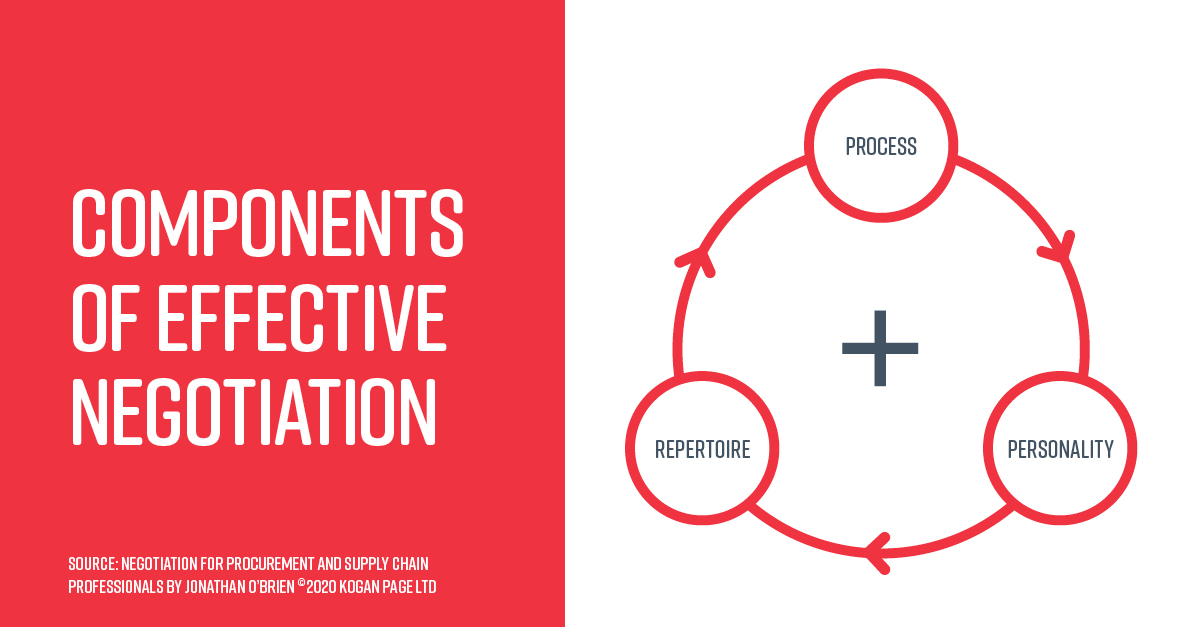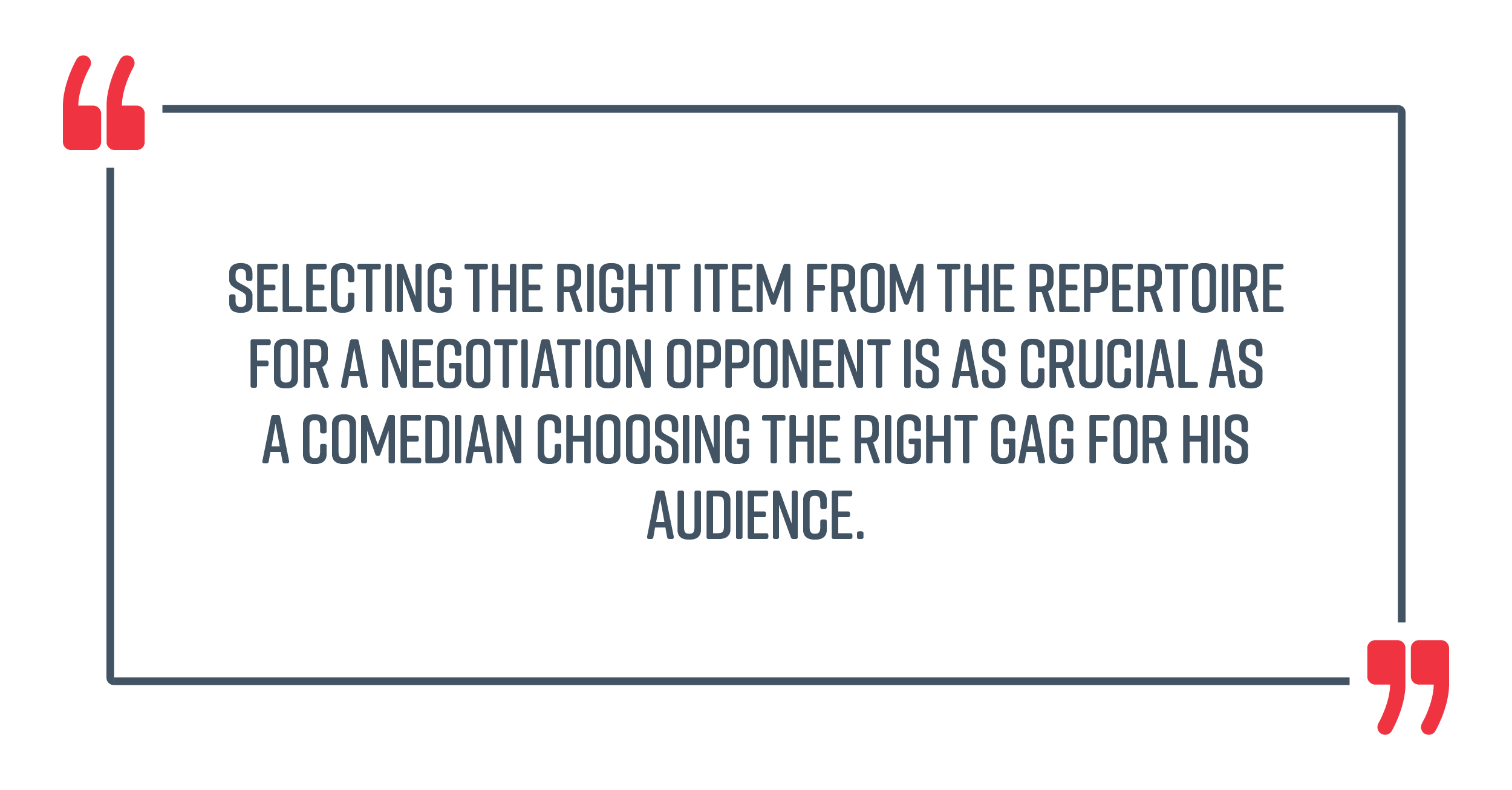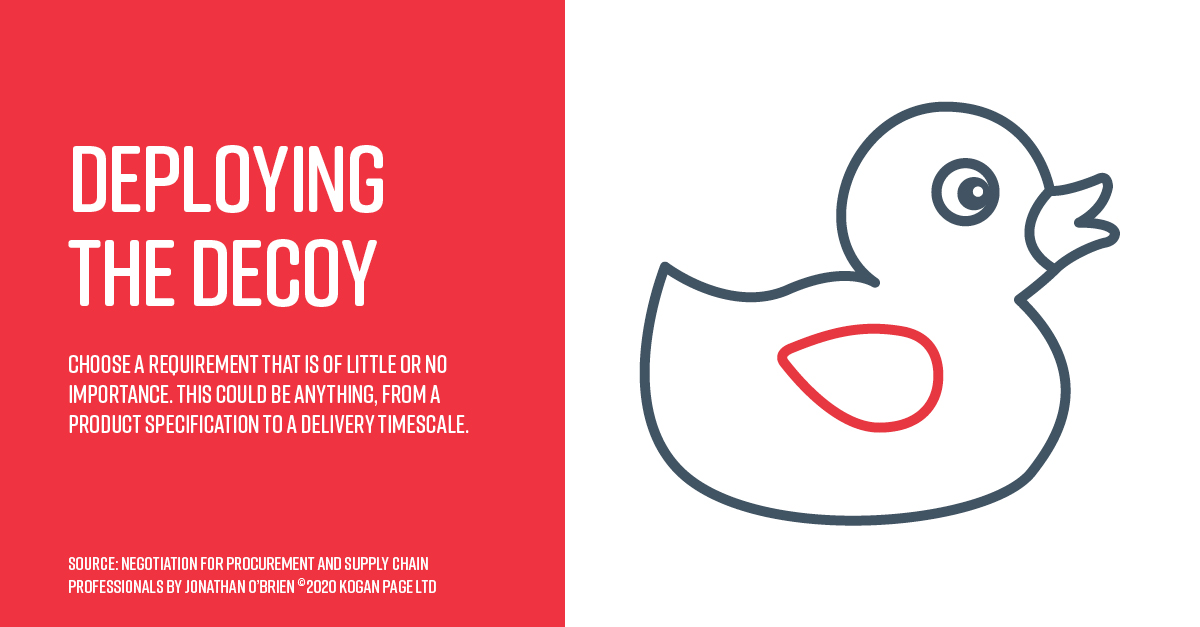Jonathan O’Brien, CEO of Positive Purchasing, explores the concept of repertoire in negotiation and use of the decoy tactic.
A negotiation is a performance of sorts.
Unsurprising then that, along with process and personality, repertoire is often referred to as a fundamental component of effective negotiation.

Usually associated with comedians or other performers, a repertoire is the entire range of material that can be delivered.
Where a performer’s repertoire might include jokes and songs, a negotiator’s repertoire contains skills and behaviours.
Effective negotiators build a strong repertoire of winning tactics and techniques for any eventuality.
In fact, selecting the right item from the repertoire for a negotiation opponent is as crucial as a comedian choosing the right gag for his audience.
Cohen (2007) describes negotiation as a ‘family of possibilities’ and this includes hundreds of negotiation tools, tactics and techniques.

The decoy
One such tactic is the decoy.
This is used when you are required to compromise. Of course, the act of compromising can indicate the relative level of importance a party attributes to each issue in a negotiation.
A decoy refers to an event, tool, or an individual meant to distract, conceal, or hide what an individual or individuals are aiming for (McCarthy & Hay, 2015).
Used to prevent giving too much away, a decoy is created by a party to pretend to give great importance to an issue or requirement that doesn’t actually matter that much to them.
By maintaining the pretence, the issue can be traded at a later stage for a major concession. In reality, however, little has been conceded and the other side will believe they have achieved an equal trade.
The decoy in practice
A decoy can be anything, from a delivery deadline to a parking space.
Example 1
For example, imagine you are buying a new car. You have agreed on the vehicle’s specification but, before signing the agreement, the salesperson mentions that there is a ten-week wait. Although the delivery date is not important to you, you pretend that it is, hoping that you will be offered a further concession. You may even tell the salesperson that you will buy a car somewhere else if he doesn’t offer something to make up for the fact you will have to wait.
Example 2
A business owner is negotiating with a landlord about leasing an office. The landlord may say that there are only two parking spaces with the unit. While this is ample for the business owner’s requirements, he might pretend that this is a huge issue and that he was looking for three parking spaces, suggesting he can only compromise if the landlord offers a concession, such as a monetary discount that will enable him to purchase a parking permit elsewhere.
How to use the decoy
There are three simple steps involved in using the decoy.
- Choose a requirement that is of little or no importance. This could be anything, from a product specification to a delivery timescale.
- Develop a series of believable arguments to make it seem important. In order for this tactic to work, your opponent must believe what you are saying!
- Deploy these arguments. You must insist the matter is important and hold firm to your position. No concessions should be made initially. You can return later to offer a concession for a trade.

Countermeasures
Of course, the decoy is a well-publicised tactic so there is every chance it could be used against you.
In this event, there are a number of possible countermeasures.
First, if your opponent suggests that a seemingly trivial issue is very important, ask questions about what is driving the importance. This will help you to gauge whether they are genuine.
Secondly, if you suspect that a decoy has been launched, why not call their bluff? Ask them to rank the importance of the requirement against something that has already been discussed. This implies you can accommodate the decoy request, but it will mean forgoing other aspects of the agreement. Use language like, ‘We can only compromise so far. Is this more important than the other issue?’
Finally, watch the other party closely to notice when they might be bluffing. Any negotiation training should include body language as this will give valuable clues about what they’re thinking or feeling. There will always be signs such as body language that will suggest all is not as it seems.
A question of ethics
Make no mistake, this is a controversial tactic. After all, honesty is said to foster lasting relationships and repeat business.
Some commentators describe the decoy as ethically questionable as it is not a straightforward approach but instead uses distraction techniques to trick an opponent.
A few go as far to describe it as deceitful or dishonest. As such, there is a danger that employing the decoy could harm your reputation and, ultimately, that of your business.
At the end of the day, whether a tactic is ethical or not is a matter of personal judgement.

Deploying the repertoire
In any negotiation, there are simply hundreds of tactics and techniques available. It is our personal repertoire of these that defines our negotiation style.
Repertoire is also about learning what to use when, particularly in the midst of a negotiation.
It is up to you, as a negotiator, to decide the content of your repertoire and, when the going gets tough, deploy the right tactics and techniques at the right time to achieve a successful outcome.
Written by Jonathan O’Brien, leading expert on procurement and negotiation, and CEO of Positive Purchasing Ltd.
This blog includes excerpts from “Negotiation for Procurement and Supply Chain Professionals” by Jonathan O’Brien, ©2020 and reproduced with permission from Kogan Page Ltd.
Click here to discover our Negotiation program
References
Cohen, R (1997) Negotiating Across Cultures: International communication in an interdependent world (rev edn), United States Institute of Peace, Washington DC./ Accessed: https://www.academia.edu/12998033/Negotiating_across_cultures
McCarthy & Hay (2015) Advanced Negotiation Techniques, Apress